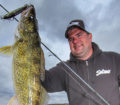By Steve Weisman
Deer hunting is extremely popular in Iowa with nearly 200,000 hunters taking to the field each year. Unfortunately, there is a disease that keeps making its way closer and closer to northwest Iowa: Chronic Wasting Disease (CWD). In looking at several recent Iowa DNR news releases, this is the what I have found.
Most recently, a tissue sample from a road-killed deer collected on the south side of Sioux City is undergoing more detailed testing after initial tests showed a significant likelihood that the disease was present. As a result, the Iowa DNR is putting Woodbury County on a disease surveillance priority.
If the disease is confirmed, Woodbury County would become the fifth Iowa county where a wild deer has tested positive for the always-fatal disease. To address the issue, the Iowa DNR has established a priority zone for tissue collection in Woodbury County extending 10 miles around where the positive sample was collected. At the same time, it is working to have a map available online at www.iowadnr.gov/cwd. Hunters harvesting a deer in this priority zone or outside the zone in western Woodbury County are encouraged to contact the DNR at (712) 420-4484 to arrange for sample collection. The only way to diagnose CWD is through lab testing of brain and lymph node tissue.
To address the issue and share information with the general public and hear feedback from those
in attendance, the Iowa DNR held a public meeting at the Sergeant Bluff Community Center on Wednesday, Jan. 15.
A little history
So many questions and concerns about the issue, so I felt the need to some research on CWD. According to the Centers for Disease Control and Prevention, “CWD was first identified in captive deer in a Colorado research facility in the late 1960s and in wild deer in 1981. Since 2000, CWD has increased to states in the Midwest, Southwest and even areas on the East Coast. As of November 2019, there were 281 counties in 24 states with reported CWD.”
According to the Iowa DNR, CWD was first confirmed in Iowa’s wild deer in the northeast county of Allamakee County in 2013. Two other counties in northeast Iowa -Clayton and Dubuque – have also had confirmed cases, followed by Wayne County in southern Iowa.
What is chronic wasting disease
This is what I found from the DNR website…Chronic wasting disease is a neurological disease affecting primarily deer and elk. An abnormal protein, called a prion, affects the brains of infected animals causing them to lose weight, display abnormal behavior and lose bodily functions. Identifying signs of CWD include excessive salivation, thirst and urination, loss of appetite, weight loss, listlessness and drooping ears and head…it is always fatal to the infected animal.
Here is one of the problems. It is a slowly progressive disease with signs not usually seen until the animal is 18 months of age or older. Often, deer are harvested and appear to be healthy animals. According to the DNR, nearly all of the deer that have tested positive in Iowa so far have appeared to be healthy and did not exhibit any signs of the disease.
That becomes a real issue if a diseased animal’s carcass is left on the landscape or transported to another area of the state. When cleaned and bodily fluids of the diseased animal enter the soil, other deer might come in contact with the disease. Scientists at the Center for Disease Control and Prevention believe that CWD proteins (prions) likely spread between animals through bodily fluids like feces, saliva, blood and urine either through direct contact or indirectly through the contamination of soil, food or water.
That is where things get dicey. Let’s say a diseased deer is field dressed and blood and other bodily fluids enter the soil. These same scientists think that the CWD prions can remain in the soil for a long time after the affected deer has been removed. If healthy deer come in contact with those prions, CWD can definitely be easily spread.
From the same Center for Disease Control and Prevention report, “Nationwide, the overall occurrence of CWD in free-ranging deer and elk is relatively low. However, in several locations where the disease is established, infection rates may exceed 10 percent (1 in 10), and localized infection rates of more than 25 percent (1 in 4) have been reported. The infection rates among some captive deer can be much higher, with a rate of 79 percent (nearly 4 in 5) reported from at least one captive herd.”
Does that mean we need to quit deer hunting? The answer is no! However, it does mean that we need to be more careful how we handle harvested deer, you know, how we handle and dispose of the remains. DNR officials encourage people seeing a deer exhibiting CWD symptoms to immediately contact the DNR. Locally, that would be the area conservation officer or the local wildlife unit.
In addition, if a deer hunter is concerned about the status of a deer that has just been harvested and think the deer should be tested, contact the area conservation officer or the local wildlife unit.
Ways to fight CWD
The DNR offers hunters three ways to help control CWD.
- PROVIDE THE SAMPLE. The DNR collects tissue samples in every county and by thorough testing, the disease can be tracked. All you need to do is CALL and a DNR biologist will come to you to collect a sample.
- STOP THE SPREAD. Do not use feed or salt mineral licks to attract deer. These baited sites increase the concentration of deer which spreads the disease.
- PROPERLY TRANSPORT AND DISPOSE. Do not leave a carcass or bones to decay on the land. Disposal with residential waste is permissible. Contact your local waste hauler for requirements. Make absolutely sure not to transport and dump carcasses outside of the area where the deer were shot, as this will spread the disease to new areas.
There are so many articles written by biologists from across the country about Chronic Wasting Disease. Definitely a good source of reading material on a windy, snow winter evening!


















